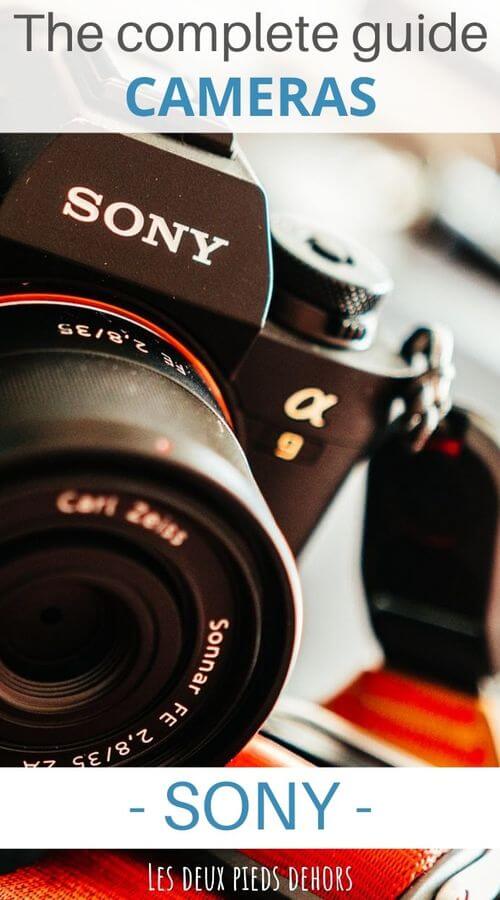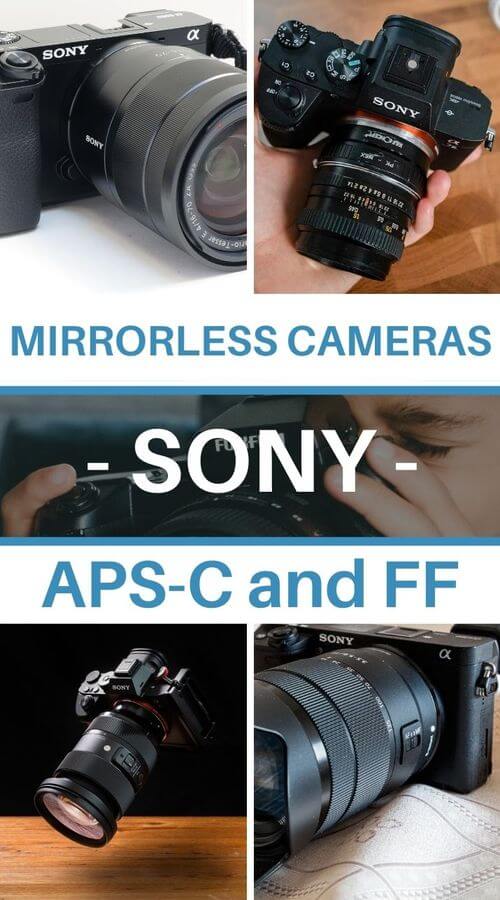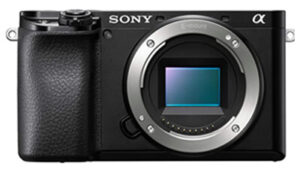Complete guide to Sony mirrorless cameras
Last update: 04/19/2024
Our blog continues to grow thanks to you, our readers. This post may contain affiliate links, which means we can earn a small commission if you make a purchase through them, at no extra cost to you. This helps us to continue to bring you more and support our work!
Unlike historical companies such as Nikon or Canon, Sony has quickly turned to mirrorless cameras, helped by the fact that it did not have such a large user base in DSLR and that their DSLRs were already more or less hybrids (since they used an electronic viewfinder). It was therefore logical for Sony to get rid of a mirror that had become more or less useless. Today, all the research and development of manufacturers go to mirrorless. At the end of 2013, Sony announced its Alpha A7, a new range of mirrorless camera with a large sensor, the full-frame, which changed the game! Sony then takes the lead in the market of mirrorless cameras with interchangeable lenses. On this subject, we wrote an article about the best choice of Sony lenses depending on what kind of photographer you are (yes!).
The boundary between the DSLR and the mirrorless’ worlds is gradually disappearing to the benefit of the latest. In this article, I will detail the different ranges of mirrorless from Sony, including the most recent cameras. Indeed, with the arrival of the latest digital cameras like the Alpha 9 II or the impressive Alpha 1, mirrorless cameras have nothing to envy to DSLRs! If you’re interested, I wrote a full article about the differences between DSLR and mirrorless cameras.
Of course, DSLRs are not (yet) dead, but… Let’s have a closer look at the different Sony mirrorless digital cameras, with APS-C sensors in a first paragraph, and full frame sensors and their uses in a second one. Wondering which Sony camera to choose? I’ll tell you everything!
01/19/2023
- Addition of the Sony A7R V Full frame mirrorless camera
For your information, we are not sponsored to write this article which contains affiliate links. Also, if you like our content, you can use B&H or amazon links for your purchase. We will get a small commission at no extra cost to you of course. This allows us to keep producing free, quality, independent content without advertising. Thank you for your support.
Before getting started, and especially if you are looking for a camera, I invite you to check our full guide explaining everything you need to know to choose a camera.
Sony APS-C mirrorless cameras
Let’s start this article with APS-C sensors. These sensors are, as you know, smaller than the so-called Full Frame sensors. But depending on the use and the type of pictures you want to shoot, they have the advantage of enjoying a magnification ratio and are often more compact than their full frame equivalents. I’ll present here two bodies classified as semi-pro, which are therefore in the “top of the range” of APS-C from Sony. I’ll also quickly talk about two other cameras (A6100 and A6400), both released at the same time as the current top-of-the-line APS-C camera (A6600).
If you are looking for a Sony APS-C camera, I invite you to have a look at all Sony E lenses fitting on this mount. You can also check out Canon’s RF APS-C mirrorless cameras, released in June 2022.
Sony ZV-E10
Recent and isolated camera from the more photography-oriented Alpha range, the Sony ZV-E10 is an 24MP APS-C mirrorless camera clearly designed for vloggers. It takes over from the ZV-1, a very successful expert compact, for those looking for better image quality and more creative options.
The ZV-E10’s specs are identical to the Sony A6100, from its 24MP sensor to its autofocus system, including its 24p 4K video capabilities without cropping. But more than just an A6100 without a viewfinder, the ZV-E10 aims to make video capture a simple, high-quality affair.
Let’s now take a closer look at the vlogging features this ZV-E10 offers: good quality over-sampled 24p and uncropped 4K capture, as well as high-speed shooting capabilities up to 1080/120p, headphone and microphone ports, an articulating selfie touchscreen, a high-quality built-in vlogging microphone, industry-leading video autofocus performance, hassle-free livestreaming capability, and very good battery life.
But this ZV-E10 has two drawbacks: poor rolling shutter performance in 4K and poor-quality Full HD footage.
So, you’re looking here at a small, versatile video camera with features that will appeal to content creators on YouTube, TikTok and Instagram. We’re not far from the vlogger’s dream, both in terms of price and features. But for those who want to shoot something other than static images, there is no video mode on this camera that produces trouble-free footage… And we can regret the lack of stabilization.
Sony A6600
The Sony a6600 is the company’s top-of-the-line APS-C mirrorless camera, and the successor to the a6500. At first glance, it looks a lot like the other cameras in Sony’s a6000 series with 24 MP resolution, 11 fps burst and 4K video capture. However, it has the largest battery and therefore the best battery life with 810 frames. The a6600 further differs even more by offering in-body image stabilization, which is still rare among APS-C cameras. This should help when shooting in low light conditions as well as for handheld videos.
Like the a6400 and a6100 models released at the same time as this one (and which I’ll quickly mention below), the a6600 offers the latest version of Sony’s autofocus called “Real-time Tracking AF”: it is able to track non-human subjects as well as human faces, eyes and even some animals with tenacity.
When it comes to video, the a6600 continues the momentum of this lineup by offering good quality, highly detailed 4K video and a fairly substantial set of capture aids. Finally, the a6600 offers weather sealing, Wi-fi, and comes equipped with a headphone port and a microphone port.
All in all, it’s a solid, high-performance camera with always state-of-the-art autofocus, image stabilization and unbeatable battery life. But for Sony’s top of the line model, and when you look at the competition (like Panasonic’s G9 and Fujifilm’s X-T4), it lacks a little something extra, other than good photos or videos, to stand out…
Sony A6100 and A6400
With the release of the a6400 a few months before and the announcement of the a6100 at the same time as the a6600, here is the APS-C mirrorless trio of the Sony catalog.
All these three cameras have the same sensor definition at 24MP and a burst rate of 11fps. No matter which camera, you’ll find the latest autofocus technologies with eye tracking of people and animals in the picture. The a6100 is Sony’s entry-level mirrorless camera. Without sensor stabilization, like the a6400, and with a less defined electronic viewfinder, it still has excellent image quality. The same quality is also there on the a6400, and it inherits, in addition, a higher ISO range and a high light mode to avoid overexposures. As for video, the a6400 is more efficient with a better autofocus and more capture aids.
Last but not least, the absence of USB-C on both cameras is a real shame when you see that all competitors are equipped with it…
Sony Full frame mirrorless cameras
Let’s continue our review of Sony’s mirrorless cameras with its full-frame range. At the end of 2013, Sony launched its Alpha A7, a new range of cameras with 24×36 sensors (known as full frame) and took its place in the big league with each new release. We’ve come a long way since the first versions, and you will notice that the recent releases are now a concentrate of technologies.
If you are thinking about choosing a Sony full frame camera, you can already look at all the Sony FE lenses available for your future camera!
Sony A7C
The Sony a7C is the company’s smallest full frame mirrorless camera. As far as looks are concerned, this camera looks more like the a6600 with APS-C sensor than like its counterparts of the a7 series. In terms of specifications, the a7C has a lot in common with the existing a7 III (which I chose when I switched to mirrorless). It features a 24MP full frame sensor, a burst rate of up to 10fps, an ISO range of 100 to 51200, Wi-fi, and a large battery allowing for 740 shots. All this in a much more compact and lighter body than the a7 III, with an image stabilization system.
The big news from the brand’s sports cameras is the latest implementation of Sony’s AF called “Real-time tracking AF”. This system tracks the subject, both in photos and videos, and automatically uses its eye, face, or head recognition function. The camera can also use subject recognition to track animals. And that’s a big step up from the a7 III.
When it comes to video, the a7C meets the a7S III by offering a fully articulated screen, 4K video with 24p footage taken across the entire sensor width, and 30p taken from a slight 1.2X crop. The camera has headphone and microphone jacks to facilitate capturing clean audio.
Performance-wise, the a7C is essentially an a7 III with better autofocus. But its major advantage is its small size, and without too many concessions! The big compromise, which is a shame, will be the tiny, compact camera-like viewfinder.
Sony A7 IV
The Sony a7 IV is the fourth generation of the company’s a7 full-frame mirrorless core model. It’s the most advanced to this day, bringing many improvements since the a7 III launched in February 2018.
At the heart of the a7 IV is a new 33MP sensor, still 10fps burst (in compressed RAW), an ISO range of 100-51200 (expandable to 102400), sensor stabilization, and battery life at 670 shots.
Autofocus is one of the big improvements over the a7 III. The a7 IV incorporates Sony’s latest AF tracking system, which means it uses pattern, color, brightness, eyes and face detection, as well as animal detection. For the first time, these animal detection capabilities also extend to the camera’s video mode. And in practice, this system is very reliable.
The other big improvement is about video capabilities. The a7 IV takes things considerably further, adding 10-bit capture and action capture, or slow-motion work with 4K 60p, still requiring cropping to APS-C/Super 35 dimensions (but no cropping to 4K 30p). You’ll also be able to stream live video via its USB connection.
Highly anticipated by photographers looking for a versatile (stills/video) 24×36 body, the a7 IV is a very capable camera, with much improved video and a more sophisticated autofocus than the a7 III. But this one still does most of the things the a7 IV can do very well in photos, despite a generation late autofocus and for a lower cost. On the other hand, the ergonomics of the body and the organization of the menus have been modified for more comfort, in particular with a switch to put the camera either in photo or in video mode, allowing the assignment of shortcuts according to the mode.
However, the A7III remains in my opinion a very good alternative, less expensive. I personally chose to “start” with the A7III when I switched to mirrorless.
Sony A7S III
The Sony alpha 7S Mark III is the third generation of the Sony a7 series of full frame cameras, the most video oriented.
While the 12MP resolution hasn’t changed, the a7S III features a different sensor than the one used by its two predecessors, supposedly improving its low-light performance. Burst is at 10fps, and the default sensitivity ranges from ISO 80 to 102,400, expandable from ISO 40 to 409,600. Unlike previous “S” cameras, you can enjoy Sony’s face detection and AF eye tracking technology here. Detection that also includes animals, as on the rest of the top of the line.
When the a7S III was introduced, Sony wanted to position this full frame hybrid as one of the best cameras for producing 4K. So, it’s essentially a native 4K camera with impressive video specs and a revised user interface. The a7S III can shoot 4K UHD at up to 60p from full width or 120p with 1.1x cropping. But what is most useful for videographers is that this a7S III offers a variety of 10-bit formats, allowing a great flexibility in terms of calibration and workflow.
The Sony a7S III is a powerful video tool with reliable autofocus, in-camera stabilization and good battery life. With its 12MP resolution, it’s less impressive as a camera, but it’s a great choice for videographers. Here too, Sony has changed the menu organization often criticized on previous cameras.
Sony A7R IV
We’re now on the company’s high-resolution-focused “R” line. Compared to previous generations, the a7R IV promises a more robust build quality, refined controls, the latest implementation of the company’s autofocus, and more…
We find a 24×36 sensor, but with a definition of 61 Mpx. The powerful processor is inherited from the A9. Despite its very high resolution, the a7R IV can take up to 10 frames per second. The a7R IV has a more powerful autofocus tracking system available in both stills and video, and for both humans and animals. Like its predecessor the a7R III, the a7R IV extends its sensitivity from ISO 50 to 102,400 with good and progressive electronic noise management up to ISO 12,800. The user interface and ergonomics have also been improved with SD card ports both UHS-II compatible. Sony has as well updated the camera’s waterproofing.
As for video, there are few changes. The camera shoots 4K video up to 30p across the sensor. The rolling shutter remains quite important in 4K/UHD.
The autofocus system is simpler and more powerful, and the improvements in the user interface play a role as important as the increase from 42 to 60 megapixels. The result is a mirrorless camera that lets you completely focus on photography and make the most of all those megapixels. Despite still having some flaws and lagging the competition in video, this a7R IV is a powerful and complete camera that will let you print any photo at billboard size if you want to.
Sony A7R V
At the end of 2022, Sony releases the follow-up to the Sony A7R IV, logically named Sony A7R V. If it uses the A7R IV’s 61MP sensor and its ISO sensitivity range from 100 to 32000 native, it differs on many points and is a real improvement.
It comes with a dual processor bionz XR, like the A1, A7S III and A7 IV, but also an AI chip supposed to improve subject detection and predict more effectively their movements. Thus, the AF is an important point of improvement of this A7R V, which integrates subject recognition previously unseen by Sony (especially vehicles) and even unknown with insect identification, although the latter is not yet very well advanced and will probably be improved by update. Human detection, Sony’s strong point, is even more efficient. We can note however a lower electronic burst rate than the A7R IV, but the fact that it is not a stacked sensor on the one hand and that Sony has 2 high-end sport cameras to protect on the other hand (the A9 and A1) explain in part this choice. In short, it is more dedicated to a mechanical shutter use. The electronic viewfinder has also been improved, since it uses the excellent A1 viewfinder, the best currently on the market, more defined and with a 0.9x magnification. So you have a wide and comfortable EVF.
Ergonomics underwent also a lot of changes. First, the rear screen that no longer chooses between tilting or swiveling but is mobile on 4-axis, ie it can do both. A system that we hope to spread, and not only from Sony. The camera body is a bit more robust, similar to the A1, A7S III and A7 IV, and it has gained a few dozen grams but benefits from a much more efficient stabilization system, a point on which Sony was often criticized by the competitors. Some buttons have changed place and the exposure compensation wheel can be assigned to another function, as with the A7 IV. The menu, criticized by many people, has also been updated to the clearer one of the last released cameras, although there are still some inconsistencies. The mechanical shutter release noise is still as quiet as with the A7R IV, one can wonder why they didn’t make as much effort on this point for the A7 IV which is much noisier.
As for video, Sony finally takes advantage of its 61MP sensor to shoot 8K at 30 fps. 4K60p is also part of the game, and in both cases with a 1.2x crop which is certainly regrettable but already much better than the 1.5x crops found on most cameras around 2500€. Non-stacked sensor, rolling shutter is still present although it is more discreet than on its predecessor.
The A7R V is therefore on many elements the best Sony can offer today, which makes it a very multipurpose camera that can deal with all situations. The last main weak point is that it does not have a stacked sensor which would reduce the defects it has in electronic shutter, a relatively slow burst rate compared to the market and defects such as rolling shutter or banding, and would make the use of 100% silent shutter more pleasant.
Sony A9 II
The Alpha 9 II is the latest high-end sports camera from Sony. This new version brings some improvements that make it a very good compact option for professional sports and action photographers.
Like its predecessor the a9, the Alpha 9 II carries over a 24.2MP sensor. Its default sensitivity ranges from ISO 100 to 51,200 and can go up to ISO 204,800. The electronic noise management is very good. It has continuous shooting at 20fps with electronic shutter full AF. But the big difference with its predecessor is the new mechanical shutter allowing 10fps bursts with full AF; which is very important for indoor sports photographers. Connectivity has also been revised with a USB-C 3.2 socket and, for easier image transfer, a Gigabit Ethernet port as well as 5GHz Wi-Fi.
Among the improvements, the a9 II gets the same ergonomic updates as the a7R IV with a better grip and two UHS-II SD card slots. It has better waterproofing too. The a9 II also features a new, faster processor which, along with updated AF algorithms, gives an improvement in autofocus speed (which was already very good on the a9). Finally, the stabilization system of the body has been improved.
As for video, Sony has a motto: 4K UHD for everyone, but the top of the top is reserved for the a7S series. Here, we find ourselves with a camera that can record footage up to 4K UHD at 24 fps without cropping, and 30 fps with a crop of 1.24x.
This is definitely a sports and action camera. With flawless autofocus, good grip, excellent RAW and JPEG files, good battery life, and solid video capture, it’s a great value for anyone looking to capture fast-moving subjects. But of course, all this performance and speed comes at a cost! Admittedly, still less than a Canon 1DX III or Nikon D6…
Sony A1
Sony presents the Alpha 1 as the camera that can do just about anything you need, whether it’s fast action, landscapes, or high-end video. It’s the full-frame camera of all superlatives!
It has a 50MP full-frame CMOS sensor, 30fps continuous shooting with electronic viewfinder, a state-of-the-art autofocus, a tilting touchscreen… All this in a waterproof body, of reasonable size and with the most complete connectivity. Sony has taken two major developments from the mirrorless dedicated to video, the a7S III: the clearer and more readable menus, and the electronic viewfinder considered the best on the market.
When it comes to video, the a1 has most of the features of the a7S III, but its higher resolution sensor allows it to capture 8K footage using the full width of the sensor. It can also shoot 4K 120p with 1.13x cropping.
It really seems like Sony has put everything possible into the a1, resulting in an extremely impressive camera for all types of use. There is so much more to say as this a1 dominates the hybrid empire in all categories. Sony has just introduced a unique camera that could meet the needs of almost any professional photographer. But this technology monster is out of reach for many of us!
Also note that its 30-fps burst is not allowed with all lenses, those of third-party brands such as Sigma and Tamron for example will be limited to around 15 fps.
Specifications table
| Camera | ISO | Weight | Size | Range | Focusing points | Burst rate (fps) | Autonomy | Wifi (BT) | Video | MP |
|---|---|---|---|---|---|---|---|---|---|---|
| Sony ZV-E10 | 100 - 25600 | 343 g | 115 x 64 x 45mm | Semi-pro | 425 | 11.0 fps | 440 | yes (yes) | 4K 30p | 24.2 MP |
| Sony α6600 | 100-32000 (102400) | 503 g | 120 x 67 x 69 mm | Semi-Pro | 425 | 11.0 fps | 810 | yes (yes) | 4K 30p | 24.2 MP |
| Sony α6400 | 100-32000 (102800) | 403 g | 120 x 67 x 60 mm | Expert | 425 | 11.0 fps | 410 | yes (yes) | 4K 30p | 24.2 MP |
| Sony α6100 | 100-32000 (102800) | 396 g | 120 x 67 x 59 mm | Expert | 425 | 11.0 fps | 420 | yes (no) | 4K 25p | 24.2 MP |
| Sony α7C | 100-51200 (204800) | 509 g | 124 x 71 x 60 mm | Expert | 693 | 10.0 fps | 440 | yes (yes) | 4K 30p | 24.2 MP |
| Sony α7 IV | 100 - 51200 (102400) | 658 g | 131 x 96 x 79.8 mm | Expert | 759 | 10.0 fps | 670 | yes (no) | 4K 30p | 33 MP |
| Sony α7S III | 80-102400 (409600) | 699 g | 129 x 97 x 81 mm | Semi-Pro | 759 | 10.0 fps | 600 | yes (yes) | 4K 120p | 12 MP |
| Sony α7R IV | 100-32000 (102800) | 665 g | 129 x 96 x 78 mm | Semi-Pro | 567 | 10.0 fps | 670 | yes (yes) | 4K 30p | 61 MP |
| Sony α7R V | 100-32000 (102800) | 665 g | 131.3 x 96.9 x 82.4 mm | Pro | 693 | 10.0 fps | 530 | yes (yes) | 8K30p | 61 MP |
| Sony α9 II | 100-32000 (102800) | 678 g | 129 x 96 x 76 mm | Pro | 693 | 20.0 fps | 690 | yes (yes) | 4K 30p | 24 MP |
| Sony A1 | 50 - 32000 (102400) | 737 g | 129 x 96 x 81 mm | Pro | 759 | 30.0 fps | 530 | yes (yes) | 8K 30p | 50 MP |
Which Sony mirrorless camera to choose?
Sony’s mirrorless range is divided into two. On one side, there are the cameras equipped with an APS-C sensor, quite compact and affordable. The ZV-E10 is clearly intended for a young audience of videographers, and more particularly for vloggers and other social networks enthusiasts. The functions facilitating shooting are very practical and the autofocus modes are formidable, all for a very competitive price/quality ratio.
The a6600 is the best APS-C camera that Sony has ever released. It’s a very capable camera with always state-of-the-art autofocus, better battery life and body stabilization, which makes a real difference. It will be a good option for all photos and videos enthusiasts.
On the other side, you have the larger and more expensive full-frame 24×36 mirrorless with its Alpha 7 range. If you want a full frame camera that is practical to carry around with you on travel, daily life or vlogging, and will be very good in almost any situation, then the a7C is perfect for you.
For photographers looking for a versatile full-frame photo/video camera, the a7 IV is finally here! It’s a very powerful camera with state-of-the-art autofocus. But the high bar set by the a7 III and the existence of a series of credible rivals may complicate the choice…’We’re waiting to see the beast in the field, in real conditions. In the meantime, you can do as I did to reduce the budget and turn to an A7 III.
For all videographers, the latest in the a7S series is a powerful video tool and certainly the best for producing 4K. On the a7S III, the options are numerous, and the improvements allow impressive speeds. Ideal to make slow motion.
For high definition, I call the a7R V! For professional wedding, landscape and studio photographers, the Sony a7R IV is frankly the unbeatable camera. Gone are the days where you had to choose between speed-based and resolution-based cameras. While not our first choice for sports and action purists, for users who regularly need very high resolution and want to be able to shoot fast moving subjects when needed, the Sony a7R IV is the best option on the market today.
We are now entering the very top end of Sony’s full-frame range, reserved for the elite. The a9 II is for sports, action and event photographers, or videographers who need solid off-camera footage, as well as general photographers who want the best possible autofocus performance. The a1, on the other hand, aims for excellence and is specifically targeted at sports photographers, usually equipped with an SLR such as the Canon EOS-1D X Mark III or the Nikon D6. You have here the combination of high resolution and high speed in one body, without any compromise!
Here we are, at the end of this article detailing the latest hybrid cameras from Sony. This one will obviously evolve with every new release. You have just seen that the range of hybrids is getting bigger and bigger, and there is really something for every user and every budget. If you are curious to see what other brands can propose, you can look at our Canon APS-C mirrorless or the Canon full frame mirrorless posts.
See you soon,






















